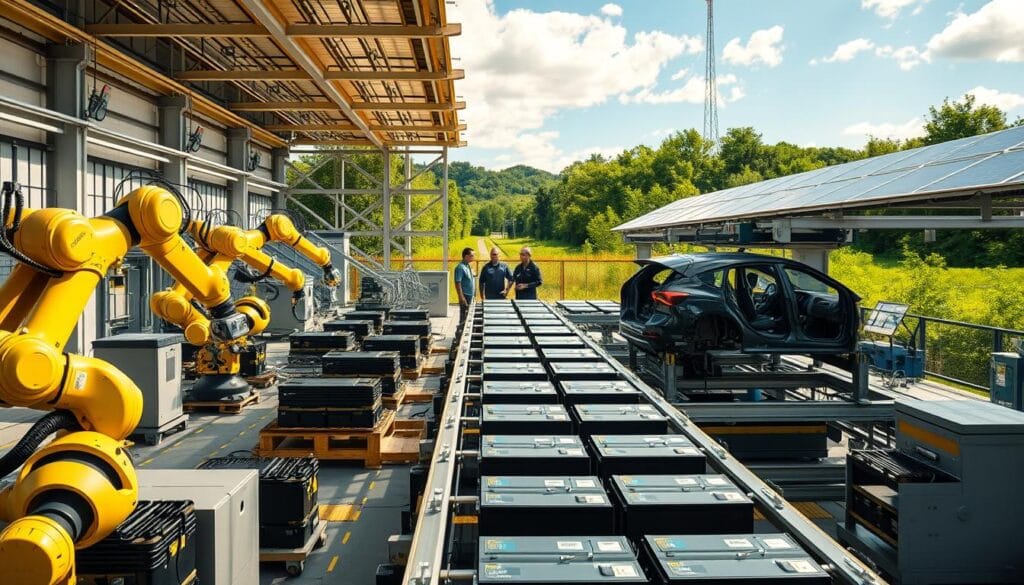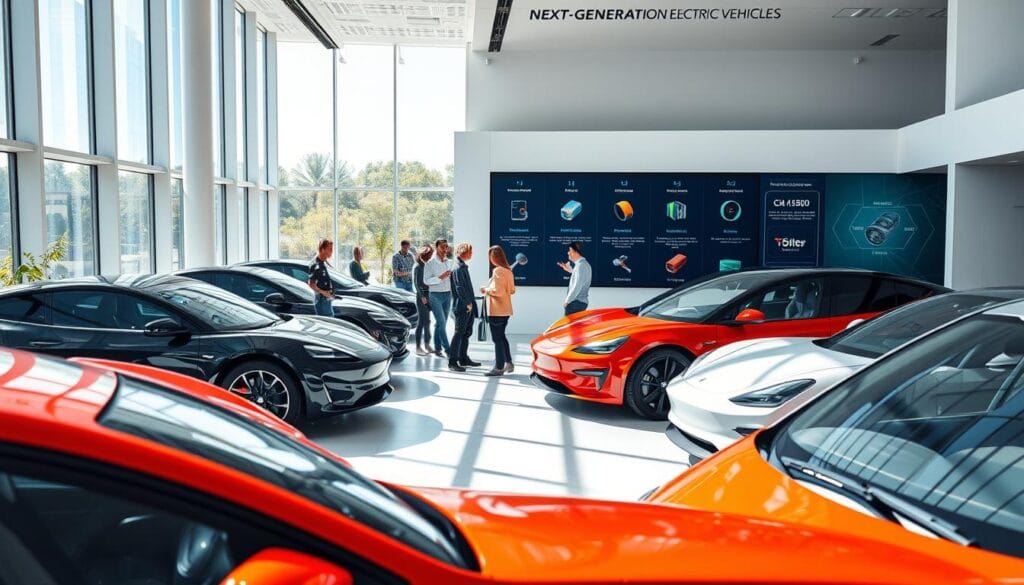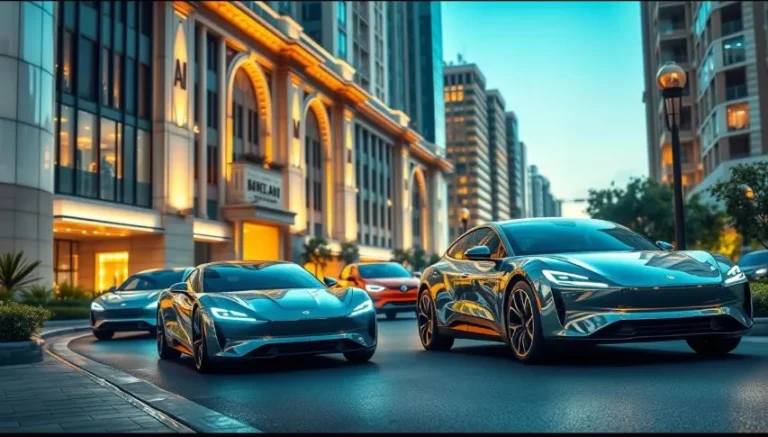Next-Gen Electric Cars: Top Models and Features Hitting Roads in 2025
Electric vehicles are set to change how we drive. In 2025, we’ll see a big leap in electric cars. These new models will make driving more sustainable and exciting.
Imagine a world where electric cars are the top choice. They offer great performance, new tech, and care for the planet. Car makers are working hard to make electric cars that are powerful and go far.
Take the Cadillac Escalade IQ with 750 horsepower or the Lucid Gravity with 440 miles of range. These cars are pushing what’s possible. They bring together the latest tech, green driving, and amazing rides.
Table of Contents
What Defines Next-Gen Electric Cars?
Electric vehicles are changing how we travel with new tech. They offer better performance and innovation. The latest electric cars have improved batteries, AI, and safety features.
These cars are getting smarter and safer. Let’s look at what makes them special.
Advanced Battery Technology
Lithium-ion batteries are getting a big upgrade. They’re now more powerful and efficient:
- Predicted range now reaches 500-600 miles on a single charge
- Charging times reduced to less than 15 minutes for 80% capacity
- Solid-state batteries enabling over 1,000 recharges
“Battery innovation is the cornerstone of electric vehicle advancement” – EV Industry Expert
AI-Driven Features
Autonomous driving is getting smarter. AI is making cars more helpful and efficient. You get better maintenance, driver assistance, and navigation.
Enhanced Safety Systems
Next-gen electric cars focus on keeping you safe. They have better crash protection and can detect pedestrians. These cars are a big step up in safety.
As electric car tech keeps improving, you’ll enjoy smarter, safer rides. This is what the future holds.
Key Upcoming Models to Watch in 2025
The electric vehicle world is changing fast. Models from Tesla, Rivian, and Lucid Motors are leading the way. They bring together new tech and amazing performance.
Tesla Cybertruck: Revolutionizing Electric Pickup Design
Tesla is shaking things up with the Cybertruck. Its unique design is a hit in the electric pickup market. It has:
- Stainless steel exoskeleton design
- Estimated range up to 500 miles
- Potential acceleration from 0-60 mph in under 3 seconds
“The Cybertruck represents a bold leap into the future of electric vehicles” – Tesla Engineering Team
Ford F-150 Lightning: The Electric Workhorse Evolves
Ford’s F-150 gets a big electric update in 2025. The Lightning now offers:
- Extended battery range
- Enhanced towing capabilities
- Advanced smart technology integration
Emerging Players: Rivian and Electric Innovation
Rivian is making a splash with the R2, a compact SUV. The R2 promises a minimum range of 300 miles. It’s a great choice for those who care about the environment.
| Manufacturer | Model | Range | Estimated Price |
|---|---|---|---|
| Tesla | Cybertruck | Up to 500 miles | $49,900 |
| Rivian | R2 | 300+ miles | $45,000 |
| Lucid Motors | Gravity SUV | 440+ miles | Under $80,000 |
These new models show how far electric vehicle tech has come. They offer great choices, performance, and are good for the planet.
How Next-Gen Cars Are Revolutionizing EV Travel
Electric vehicles are changing how we travel with new charging systems and zero emissions. The car world is shifting, making electric cars more fun and easy to use than ever.
The electric car market is growing fast. It’s expected to jump from USD 396.4 billion in 2024 to USD 620.3 billion by 2030. This change is big for how we travel.
Expanded Charging Networks
Charging stations are growing to keep up with more electric cars. Big news includes:
- Toyota’s North America division plans to establish 30,000 DC fast charging ports by 2030
- Investment from both government and private sector stakeholders is accelerating
- Innovative startups like Charge Zone are investing in super-fast charging technologies
Longer Range Capabilities
New electric cars are going further and faster. Solid-state battery technologies are making big promises:
- Toyota’s advanced batteries aim for 1,000 km range
- Charging times potentially reduced to just 10 minutes
- Commercial readiness expected between 2027-2028
Greater Customization Options
Car makers are letting you make your car your own. You can choose from many driving modes and interior setups. This means a car that fits your style and needs perfectly.
With a 20% rise in electric car sales in the US for 2024, the future of green travel is bright.
Tesla’s Supercharger Access: What It Means for Drivers
The electric vehicle charging world is changing fast. Tesla’s Supercharger network is now open to many car brands. This makes it easier for EV drivers to charge their cars across the United States.
The way we charge cars is changing a lot. In May 2023, Ford made a big deal to use over 12,000 Tesla Superchargers in North America. This move marked a new chapter in charging options.
Expanded Accessibility for Multiple Brands
More car makers are using Tesla’s North American Charging Standard (NACS). Here are some key points:
- GM will offer Supercharger access starting September 2024
- Honda Prologue and Acura ZDX owners gain access in June 2025
- Kia will provide free NACS adapters for EV6 and EV9 models
- Mercedes-Benz allows Supercharger use with a $185 adapter
Faster Charging Times
Tesla’s Supercharger network is known for quick charging. With its advanced setup, drivers can quickly add hundreds of miles to their range.
Impact on Long-Distance Travel
The bigger Supercharger network makes long trips in EVs easier. By late 2023, there were 36,499 NACS ports in the U.S. compared to 16,925 CCS ports.
| Brand | Supercharger Access | Adapter Cost |
|---|---|---|
| Ford | Available | Free |
| GM | September 2024 | $225 |
| Honda | June 2025 | TBD |
| Mercedes-Benz | February 2025 | $185 |
This change means you can plan long trips with more confidence. Tesla’s Supercharger network is now more accessible than ever.
Over-the-Air Updates: The Future of Car Maintenance
The car world is changing fast with over-the-air (OTA) updates. These updates let car makers improve your vehicle’s software from afar. You get the latest features without going to the dealership.
How Software Updates Improve Performance
Next-gen electric cars use OTA tech to boost their abilities instantly. These updates can make your driving better in many ways:
- Optimize battery management systems
- Refine autonomous driving algorithms
- Enhance energy efficiency
- Implement advanced safety protocols
Reducing Service Costs
OTA updates save you money on electric cars. They fix issues digitally, which means:
- Less money for regular maintenance
- Less chance of hardware problems
- Your car lasts longer with updates
“Software is becoming the new frontier of automotive innovation” – Auto Tech Insights
Keeping Features Up-to-Date
Autonomous driving tech is always getting better, thanks to OTA updates. By 2025, 15% of General Motors’ cars will have Super Cruise. This shows the industry’s drive for constant improvement.
By getting these digital upgrades, you’re not just buying a car. You’re getting a smart, evolving way to move around that meets your changing needs.
Sustainability Practices in Next-Gen EVs
Electric vehicle makers are changing how cars are made and designed. They aim to make cars that don’t harm the environment. This is a big step towards making cars that are good for our planet.

The move towards green manufacturing is changing the electric car world. Important changes are happening in several key areas:
- Recycled material use in car parts
- Using renewable energy in factories
- Creating closed-loop recycling systems
- Lowering carbon emissions
Innovative Material Recycling
Today’s electric car makers focus on using recycled materials. They use recycled parts for everything from the car’s body to its inside. This helps cut down on waste and supports the environment.
“Our goal is to create vehicles that are not just emissions-free, but truly environmentally responsible from production to end-of-life,” says a leading EV industry expert.
Sustainable Manufacturing Processes
Companies like Volkswagen are putting a lot into green production. They’re doing things like:
- Setting up battery testing centers
- Building factories that are better for the environment
- Using AI to make production more efficient
The car industry’s push for green cars is leading to big changes. By using recycled materials, renewable energy, and smart manufacturing, the next electric cars will be even better for our planet.
The Role of Propulsion Technologies
The world of green transportation is changing fast. New propulsion technologies are leading this change. Next-gen electric cars are at the heart of this shift.
Electric vs. Hybrid Systems: A Comparative Overview
There are two main types of propulsion systems in the market:
- Pure Electric Systems: They have zero direct emissions
- Hybrid Configurations: They mix electric and traditional power sources
In 2023, the car industry saw some key numbers:
- Battery Electric Vehicles (BEVs): 7.2% of all cars made
- Hybrid Electric Vehicles (HEVs): 13.5% of all cars made
- Plug-in Hybrid Electric Vehicles (PHEVs): 2.4% of all cars made
The Rise of Hydrogen Fuel Cells
Hydrogen fuel cell tech is becoming a big deal in green cars. By 2029, experts predict about 14,400 fuel cell electric vehicles (FCEVs) in North America. This is a small but important step towards more options for electric cars.
The future of cars isn’t just about new tech. It’s about making cars better for the planet and meeting different driving needs. As the industry keeps innovating, we’ll see more advanced and flexible electric car systems.
Consumer Preferences: What Buyers Want in EVs

The electric vehicle market is changing fast. What buyers want is key for makers like Fisker. They need to know what drives people’s choices.
Surveys show interesting facts about EV buyers. A big 60% might buy an electric car. Younger people, like Gen Z and Millennials, are really interested, with 72% and 70% wanting to own one.
Prioritizing Range and Charging Speed
Range anxiety is a big deal. People want cars that can go far and charge fast. They also want reliable places to charge.
71% of drivers go less than 75 miles a day. This makes many electric cars good for daily use.
Smart Features and Technology
Buyers want more than just a car. They want smart, connected rides. They like advanced navigation, connected services, and self-driving tech.
57% of US buyers want smart navigation in their electric cars.
Budget vs. Luxury Models
Pricing is complex. While 39% see cost as a problem, 68% of parents might choose an EV for savings.
| Consumer Segment | EV Purchase Likelihood |
|---|---|
| Gen Z | 67% likely if savings offset price |
| Millennials | 65% likely if savings offset price |
| Boomers | 41% likely if savings offset price |
The electric car world is growing. What buyers want is driving change. Makers like Fisker are making cars that are both affordable and appealing.
Navigating State Incentives and Tax Breaks
Buying electric vehicles is getting more appealing with federal and state incentives. These benefits can lower the cost of going green for buyers.
Federal Tax Credits: What You Need to Know
The federal government gives a tax credit of up to $7,500 for certain electric vehicles. To qualify, you need:
- Maximum MSRP of $80,000 for SUVs and trucks
- Maximum MSRP of $55,000 for other vehicle types
- Income limits from $150,000 to $300,000 based on filing status
- Battery components and critical minerals from specific areas
State-Specific Rebates and Incentives
States offer their own perks to boost EV use. Some highlights are:
- Colorado: $5,000 state tax credit for new EV purchases
- California: Rebates up to $30,000 for low-income buyers
- Arizona: $250 rebate for installing Level 2 charging stations
“The future of transportation is electric, and these incentives make that future more accessible than ever.” – EV Industry Expert
Using these federal and state incentives can greatly lower the cost of electric vehicles. It also helps make transportation more sustainable.
The Future of Autonomous Driving in Electric Cars
Autonomous driving tech is getting better fast in Next-Gen Electric Cars. Most cars now have Level 2 or Level 3 autonomy. But, making cars that drive themselves fully is a big challenge. Yet, car makers are working hard to make systems that help keep you safe and make driving easier.
Tesla’s Full Self-Driving (FSD) system is a good example of what’s possible today. Even though it’s called “Full Self-Driving,” it needs you to pay attention. It’s mostly at Level 2. Cars with this tech have cool tools like radar, lidar, and cameras. These help them understand what’s happening around them in real time.
Current Developments
The world of self-driving cars is complex. There are many hurdles, like how weather affects it, the limits of sensors, and rules that are not clear yet. It might take 10 years or more to have cars that drive themselves fully. Cities in China are leading the way, testing self-driving cars in over 20 places in 2025.
Expected Timelines for Adoption
Many people are not ready to trust self-driving cars yet. Even though tech is getting better, cost and safety worries are holding people back. The move to cars that drive themselves will happen slowly. But, as tech gets better, we’ll see more help in driving, making our rides safer and less stressful.
Implications for Driver Experience
As self-driving tech gets smarter, cars will become more intelligent and less work for you. The future looks bright for your daily drive. You can expect safer, less stressful commutes and maybe even a new way to see transportation.







